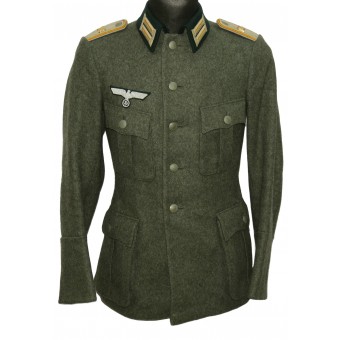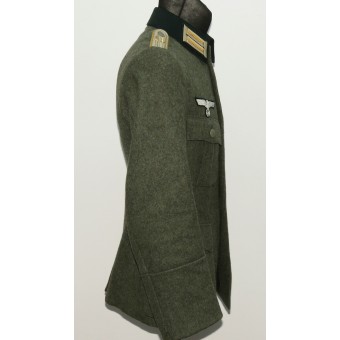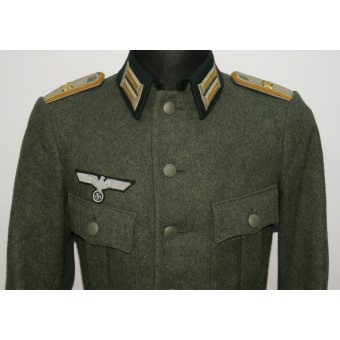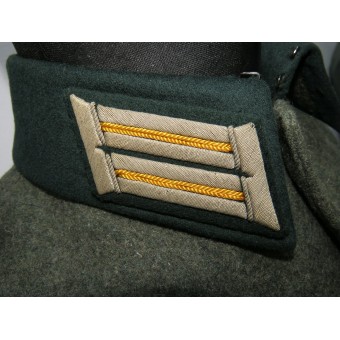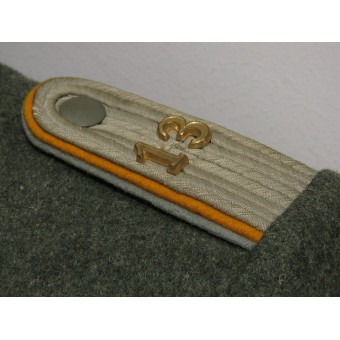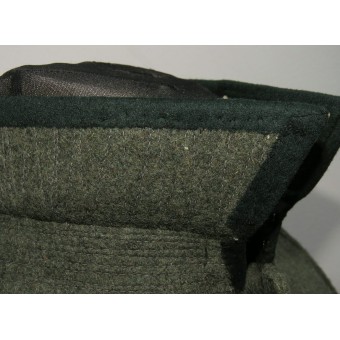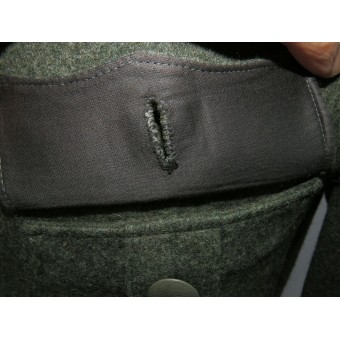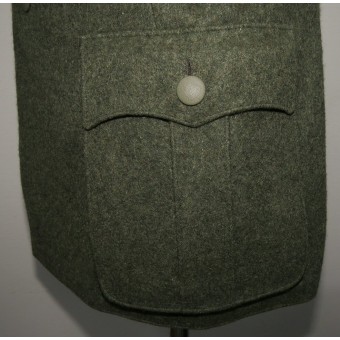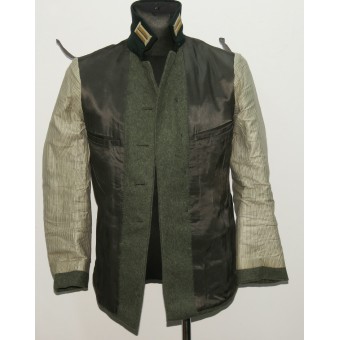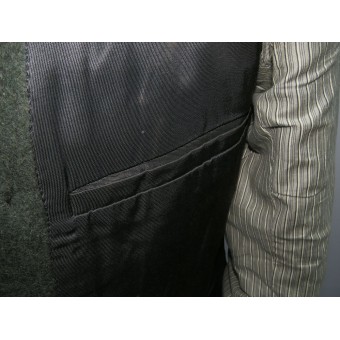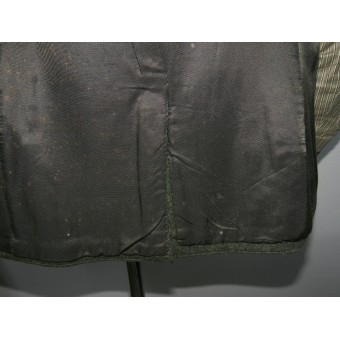Panzer Aufklärungsabteilung 13 officers tunic
Lieutenant of the reserve tunic from the 13th Armored Reconnaissance Abteilung of the Wehrmacht. Panzer Aufklärungsabteilung 13. Its condition is nearly perfect, showing virtually no signs of wear. Late type, ca mid of 1943 field wool made. Size approx 48. All insignia is original to the tunic.
The history of the 13th Reconnaissance Battalion began with its formation as part of the 13th Infantry Division, initially stationed north of Vienna. In October 1940, the unit was relocated to Transylvania, where it performed training and security functions, gaining the name Training Reconnaissance Battalion “R.” In May 1941, the battalion moved to Upper Silesia for preparations for the Eastern campaign, after which it was re-designated as the 13th Armored Reconnaissance Battalion. At the start of the Eastern campaign on June 22, 1941, the battalion crossed the Bug River, advancing through Lutsk and Rivne toward the Golsk area, where on July 7 it broke through the "Stalin Line" and continued toward Zhytomyr, eventually reaching Irpin. The battalion then advanced toward Berdichev and Kasatino. Near Dnepropetrovsk, it crossed the Dnieper River, moved toward the Sea of Azov, and then advanced through the Mius region toward Rostov. After a failed attempt to capture Rostov, the battalion withdrew to the Mius and held positions near Taganrog as part of the 13th Panzer Division until April 1942, when it merged with the 43rd Motorized Infantry Battalion. On April 1, 1943, the battalion was reorganized, incorporating several tank and motorized reconnaissance companies, and by August it was positioned at the Kuban bridgehead. From there, it was redeployed to Crimea, and then, in late August 1943, after battles near Yefremovka, the division managed to break out of encirclement and retreat to the Mariupol–Stalino line. From September to October, the battalion participated in the defense of Melitopol, then withdrew through the Noginsk Steppe. Personnel reinforcements were conducted in November 1943 in the Golaganovka area. From mid-November 1943, the battalion was heavily involved in defensive battles at the Nikopol bridgehead and east of Krivoy Rog, then near Kirovograd, and in January 1944 near Novo-Ukrainka. Further battles continued on the southern outskirts of the Cherkassy Pocket until mid-February 1944, when the division was once again forced to retreat. In early March, under increasing pressure from the Red Army, the division withdrew across the Bug River near Pervomaisk, continuing defensive actions between the Bug and the Dniester until reaching the Kishinev area in early April 1944. After the grueling summer battles of 1944, the battalion was ultimately destroyed near Kishinev. In November 1944, remnants of the battalion and a reserve company were re-formed in Hungary, on the Yörkény training ground about 50 km southeast of Budapest, where it underwent further reinforcements. In October, the battalion was stationed east of Budapest before being redeployed to the capital itself, where it became encircled and, in the fierce battles of January 1945, was once again destroyed.
Lieutenant of the reserve tunic from the 13th Armored Reconnaissance Abteilung of the Wehrmacht. Panzer Aufklärungsabteilung 13. Its condition is nearly perfect, showing virtually no signs of wear. Late type, ca mid of 1943 field wool made. Size approx 48. All insignia is original to the tunic.
The history of the 13th Reconnaissance Battalion began with its formation as part of the 13th Infantry Division, initially stationed north of Vienna. In October 1940, the unit was relocated to Transylvania, where it performed training and security functions, gaining the name Training Reconnaissance Battalion “R.” In May 1941, the battalion moved to Upper Silesia for preparations for the Eastern campaign, after which it was re-designated as the 13th Armored Reconnaissance Battalion. At the start of the Eastern campaign on June 22, 1941, the battalion crossed the Bug River, advancing through Lutsk and Rivne toward the Golsk area, where on July 7 it broke through the "Stalin Line" and continued toward Zhytomyr, eventually reaching Irpin. The battalion then advanced toward Berdichev and Kasatino. Near Dnepropetrovsk, it crossed the Dnieper River, moved toward the Sea of Azov, and then advanced through the Mius region toward Rostov. After a failed attempt to capture Rostov, the battalion withdrew to the Mius and held positions near Taganrog as part of the 13th Panzer Division until April 1942, when it merged with the 43rd Motorized Infantry Battalion. On April 1, 1943, the battalion was reorganized, incorporating several tank and motorized reconnaissance companies, and by August it was positioned at the Kuban bridgehead. From there, it was redeployed to Crimea, and then, in late August 1943, after battles near Yefremovka, the division managed to break out of encirclement and retreat to the Mariupol–Stalino line. From September to October, the battalion participated in the defense of Melitopol, then withdrew through the Noginsk Steppe. Personnel reinforcements were conducted in November 1943 in the Golaganovka area. From mid-November 1943, the battalion was heavily involved in defensive battles at the Nikopol bridgehead and east of Krivoy Rog, then near Kirovograd, and in January 1944 near Novo-Ukrainka. Further battles continued on the southern outskirts of the Cherkassy Pocket until mid-February 1944, when the division was once again forced to retreat. In early March, under increasing pressure from the Red Army, the division withdrew across the Bug River near Pervomaisk, continuing defensive actions between the Bug and the Dniester until reaching the Kishinev area in early April 1944. After the grueling summer battles of 1944, the battalion was ultimately destroyed near Kishinev. In November 1944, remnants of the battalion and a reserve company were re-formed in Hungary, on the Yörkény training ground about 50 km southeast of Budapest, where it underwent further reinforcements. In October, the battalion was stationed east of Budapest before being redeployed to the capital itself, where it became encircled and, in the fierce battles of January 1945, was once again destroyed.


